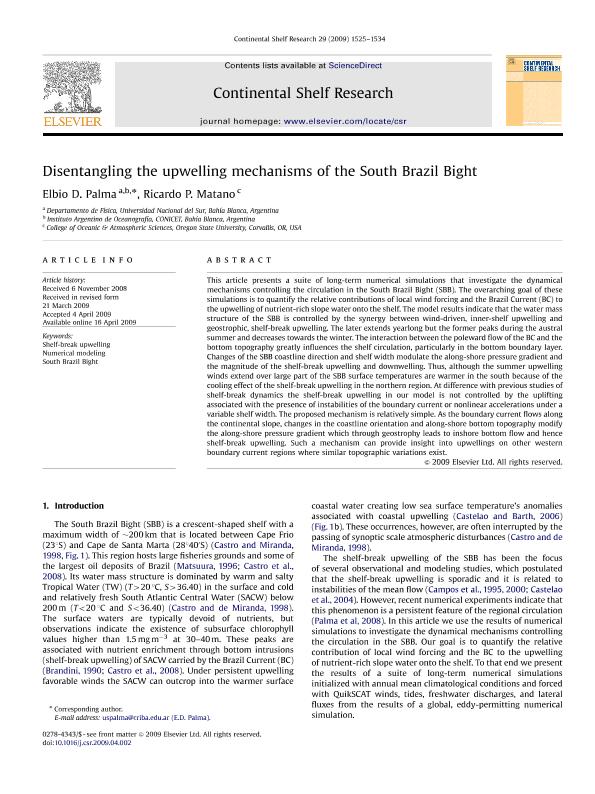Mostrar el registro sencillo del ítem
dc.contributor.author
Palma, Elbio Daniel

dc.contributor.author
Matano, Ricardo

dc.date.available
2017-11-08T16:33:42Z
dc.date.issued
2009-04
dc.identifier.citation
Palma, Elbio Daniel; Matano, Ricardo; Disentangling the upwelling mechanisms of the South Brazil Bight; Elsevier; Continental Shelf Research; 29; 11-12; 4-2009; 1525-1534
dc.identifier.issn
0278-4343
dc.identifier.uri
http://hdl.handle.net/11336/27838
dc.description.abstract
This article presents a suite of long-term numerical simulations that investigate the dynamical mechanisms controlling the circulation in the South Brazil Bight (SBB). The overarching goal of these simulations is to quantify the relative contributions of local wind forcing and the Brazil Current (BC) to the upwelling of nutrient-rich slope water onto the shelf. The model results indicate that the water mass structure of the SBB is controlled by the synergy between wind-driven, inner-shelf upwelling and geostrophic, shelf-break upwelling. The later extends yearlong but the former peaks during the austral summer and decreases towards the winter. The interaction between the poleward flow of the BC and the bottom topography greatly influences the shelf circulation, particularly in the bottom boundary layer. Changes of the SBB coastline direction and shelf width modulate the along-shore pressure gradient and the magnitude of the shelf-break upwelling and downwelling. Thus, although the summer upwelling winds extend over large part of the SBB surface temperatures are warmer in the south because of the cooling effect of the shelf-break upwelling in the northern region. At difference with previous studies of shelf-break dynamics the shelf-break upwelling in our model is not controlled by the uplifting associated with the presence of instabilities of the boundary current or nonlinear accelerations under a variable shelf width. The proposed mechanism is relatively simple. As the boundary current flows along the continental slope, changes in the coastline orientation and along-shore bottom topography modify the along-shore pressure gradient which through geostrophy leads to inshore bottom flow and hence shelf-break upwelling. Such a mechanism can provide insight into upwellings on other western boundary current regions where similar topographic variations exist.
dc.format
application/pdf
dc.language.iso
eng
dc.publisher
Elsevier

dc.rights
info:eu-repo/semantics/openAccess
dc.rights.uri
https://creativecommons.org/licenses/by-nc-nd/2.5/ar/
dc.subject
Oceanografia
dc.subject.classification
Meteorología y Ciencias Atmosféricas

dc.subject.classification
Ciencias de la Tierra y relacionadas con el Medio Ambiente

dc.subject.classification
CIENCIAS NATURALES Y EXACTAS

dc.title
Disentangling the upwelling mechanisms of the South Brazil Bight
dc.type
info:eu-repo/semantics/article
dc.type
info:ar-repo/semantics/artículo
dc.type
info:eu-repo/semantics/publishedVersion
dc.date.updated
2017-11-03T19:03:47Z
dc.identifier.eissn
1873-6955
dc.journal.volume
29
dc.journal.number
11-12
dc.journal.pagination
1525-1534
dc.journal.pais
Países Bajos

dc.journal.ciudad
Amsterdam
dc.description.fil
Fil: Palma, Elbio Daniel. Consejo Nacional de Investigaciones Científicas y Técnicas. Centro Científico Tecnológico Conicet - Bahía Blanca. Instituto Argentino de Oceanografía. Universidad Nacional del Sur. Instituto Argentino de Oceanografía; Argentina
dc.description.fil
Fil: Matano, Ricardo. State University of Oregon; Estados Unidos. Consejo Nacional de Investigaciones Científicas y Técnicas; Argentina
dc.journal.title
Continental Shelf Research

dc.relation.alternativeid
info:eu-repo/semantics/altIdentifier/doi/http://dx.doi.org/10.1016/j.csr.2009.04.002
dc.relation.alternativeid
info:eu-repo/semantics/altIdentifier/url/http://www.sciencedirect.com/science/article/pii/S0278434309001344
Archivos asociados
